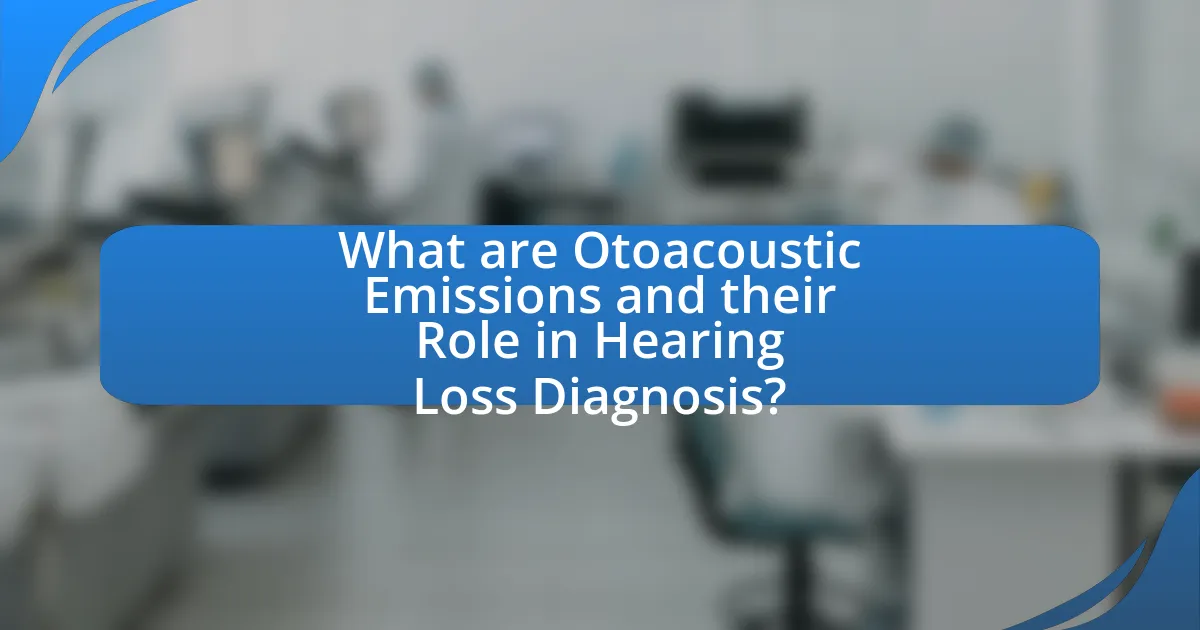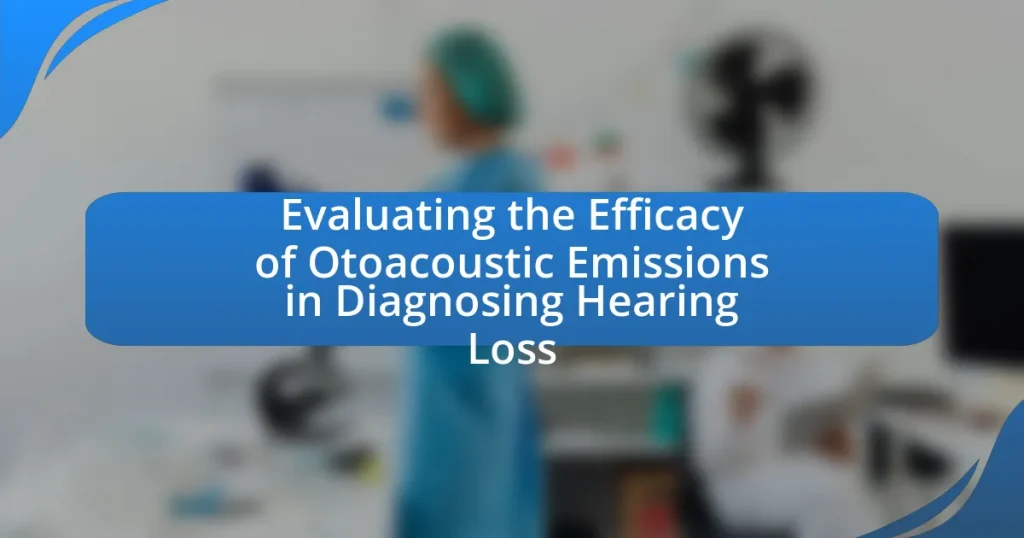Otoacoustic emissions (OAEs) are sounds produced by the inner ear’s outer hair cells in response to auditory stimuli, serving as a non-invasive method for assessing cochlear function and diagnosing hearing loss, particularly in newborns and young children. The article evaluates the efficacy of OAEs in identifying hearing impairments, highlighting their ability to detect issues before behavioral signs appear. It discusses the physiological processes behind OAE generation, the types of emissions, their advantages over traditional hearing tests, and the methodologies used to assess their diagnostic accuracy. Additionally, the article addresses the limitations of OAEs, factors influencing their reliability, and future directions for research and clinical practice integration.

What are Otoacoustic Emissions and their Role in Hearing Loss Diagnosis?
Otoacoustic emissions (OAEs) are sounds generated by the inner ear, specifically by the outer hair cells, in response to auditory stimuli. These emissions serve as a non-invasive tool for assessing cochlear function and are crucial in diagnosing hearing loss, particularly in newborns and young children. Research indicates that OAEs can detect hearing impairments even before behavioral signs are evident, making them valuable in early intervention strategies. Studies have shown that the presence of OAEs typically indicates normal hearing, while their absence can suggest varying degrees of hearing loss, thus reinforcing their role in audiological assessments.
How are Otoacoustic Emissions generated?
Otoacoustic emissions are generated by the outer hair cells of the cochlea in response to sound stimulation. When the inner ear receives an auditory stimulus, the outer hair cells undergo mechanical changes that produce sound waves, which can be detected in the ear canal. This phenomenon is a result of the active process of amplification and fine-tuning of sound within the cochlea, essential for normal hearing. Research has shown that these emissions can be measured to assess cochlear function, providing valuable insights into hearing health and potential hearing loss.
What physiological processes contribute to the generation of Otoacoustic Emissions?
Otoacoustic emissions (OAEs) are generated primarily through the active processes of the outer hair cells in the cochlea. These outer hair cells amplify sound vibrations and produce mechanical movements that create sound waves, which can be detected in the ear canal. The physiological mechanism involves the electromotility of outer hair cells, where changes in cell length in response to electrical stimulation lead to the generation of these emissions. Research indicates that OAEs are a reflection of cochlear function and can be used to assess hearing sensitivity, particularly in newborns and individuals with hearing loss.
What types of Otoacoustic Emissions exist?
There are two main types of otoacoustic emissions: spontaneous otoacoustic emissions (SOAEs) and evoked otoacoustic emissions (EOAEs). SOAEs occur naturally in some individuals without any external stimulus, while EOAEs are generated in response to auditory stimuli, such as clicks or tones. Research indicates that both types are useful in assessing cochlear function and diagnosing hearing loss, as they reflect the health of the outer hair cells in the cochlea.
Why is it important to evaluate the efficacy of Otoacoustic Emissions?
Evaluating the efficacy of Otoacoustic Emissions (OAEs) is crucial because it determines the reliability and accuracy of this diagnostic tool in identifying hearing loss. OAEs are sound waves produced by the inner ear, and their measurement can indicate cochlear function. Studies have shown that OAEs can effectively detect hearing impairment in various populations, including newborns and individuals with auditory processing disorders. For instance, research published in the Journal of the American Academy of Audiology demonstrates that OAEs have a high sensitivity and specificity for detecting hearing loss, making them a valuable component of comprehensive audiological assessments.
What are the potential advantages of using Otoacoustic Emissions in hearing loss diagnosis?
Otoacoustic emissions (OAEs) provide several advantages in diagnosing hearing loss, including their ability to detect cochlear function non-invasively and objectively. OAEs can identify hearing impairment at an early stage, even before behavioral signs are evident, making them particularly useful in newborn screening programs. Additionally, OAEs are quick to administer, require minimal patient cooperation, and can be performed in various settings, enhancing accessibility for patients. Research indicates that OAEs have high sensitivity and specificity for detecting hearing loss, particularly in the frequency range critical for speech perception, thereby supporting their efficacy in clinical practice.
How do Otoacoustic Emissions compare to traditional hearing tests?
Otoacoustic emissions (OAEs) differ from traditional hearing tests primarily in their method of assessing hearing function. OAEs measure the sound waves produced by the inner ear’s hair cells in response to auditory stimuli, providing insight into cochlear function, while traditional hearing tests, such as pure-tone audiometry, evaluate an individual’s ability to hear specific frequencies through behavioral responses. Research indicates that OAEs can detect hearing loss at earlier stages than traditional tests, particularly in newborns and infants, as they do not require active participation from the patient. Studies have shown that OAEs are effective in identifying cochlear dysfunction even when behavioral tests indicate normal hearing, highlighting their utility in comprehensive hearing assessments.

What methodologies are used to evaluate the efficacy of Otoacoustic Emissions?
The methodologies used to evaluate the efficacy of Otoacoustic Emissions (OAEs) include both objective and subjective assessments. Objective assessments involve the use of equipment to measure the presence and characteristics of OAEs in response to auditory stimuli, while subjective assessments may include patient-reported outcomes and behavioral audiometry to correlate OAE results with perceived hearing ability. Research has shown that OAEs are effective in identifying cochlear function, particularly in newborn hearing screenings, where studies indicate a sensitivity of 70-90% for detecting hearing loss.
What research studies have been conducted on Otoacoustic Emissions?
Numerous research studies have been conducted on Otoacoustic Emissions (OAEs) to evaluate their efficacy in diagnosing hearing loss. For instance, a study by Kemp (1978) titled “Stimulated acoustic emissions from within the human auditory system” published in the Journal of the Acoustical Society of America established the foundational principles of OAEs and their relationship to cochlear function. Another significant study, “The clinical utility of otoacoustic emissions in the diagnosis of hearing loss” by Hall et al. (1996), published in the Journal of Speech and Hearing Research, demonstrated the effectiveness of OAEs in identifying hearing impairment in newborns and children. Additionally, research by Gorga et al. (2006) in “Otoacoustic emissions as a screening tool for hearing loss in infants” published in the Ear and Hearing journal highlighted the sensitivity and specificity of OAEs in early detection of hearing loss. These studies collectively affirm the role of OAEs as a reliable diagnostic tool in audiology.
What were the key findings of these studies regarding diagnostic accuracy?
The key findings of the studies regarding diagnostic accuracy indicate that otoacoustic emissions (OAEs) are highly effective in identifying hearing loss, with sensitivity rates often exceeding 90%. Research demonstrates that OAEs can detect cochlear dysfunction even in the presence of normal audiometric thresholds, making them a valuable tool for early diagnosis. For instance, a study published in the Journal of the American Academy of Audiology found that OAEs had a diagnostic accuracy of 95% in identifying mild to moderate hearing loss in infants. This evidence supports the reliability of OAEs as a non-invasive screening method for hearing impairment.
How do different populations respond to Otoacoustic Emissions testing?
Different populations exhibit varying responses to Otoacoustic Emissions (OAEs) testing, influenced by factors such as age, ethnicity, and hearing status. For instance, infants and young children typically show robust OAEs due to their healthy cochlear function, while older adults may demonstrate diminished OAEs linked to age-related hearing loss. Ethnic differences also emerge, as studies indicate that certain populations, such as African Americans, may have different baseline OAE levels compared to Caucasians, potentially affecting diagnostic outcomes. Additionally, individuals with hearing impairments often present absent or reduced OAEs, which can aid in identifying the degree and type of hearing loss. These variations underscore the importance of considering demographic factors when interpreting OAE results in clinical settings.
What are the limitations of using Otoacoustic Emissions in diagnosis?
The limitations of using Otoacoustic Emissions (OAEs) in diagnosis include their inability to assess the integrity of the auditory nerve and central auditory pathways, as OAEs primarily reflect cochlear function. Additionally, OAEs can be influenced by external factors such as middle ear conditions, which may lead to false negatives in hearing loss detection. Research indicates that while OAEs are effective for screening purposes, they do not provide comprehensive information about the degree or type of hearing loss, limiting their diagnostic utility (Kemp, 2002; American Speech-Language-Hearing Association, 2020).
What factors can affect the reliability of Otoacoustic Emissions results?
The reliability of Otoacoustic Emissions (OAEs) results can be affected by several factors, including the patient’s age, middle ear status, and environmental noise levels. For instance, infants and young children may produce less reliable OAE results due to their developmental stage, while adults with middle ear pathologies, such as otitis media, can exhibit altered OAE responses. Additionally, high levels of ambient noise during testing can interfere with the detection of OAEs, leading to inaccurate results. Studies have shown that these variables significantly impact the sensitivity and specificity of OAEs in diagnosing hearing loss, underscoring the importance of controlled testing conditions and patient selection.
How do environmental conditions influence Otoacoustic Emissions testing?
Environmental conditions significantly influence Otoacoustic Emissions (OAE) testing by affecting the accuracy and reliability of the results. Factors such as ambient noise levels, temperature, and humidity can alter the sensitivity of the equipment and the responses of the cochlea. For instance, high ambient noise can mask the faint emissions produced by the inner ear, leading to false negatives in hearing assessments. Studies have shown that optimal testing environments, typically characterized by low noise levels and controlled temperature and humidity, yield more consistent and reliable OAE results, thereby enhancing the diagnostic efficacy in identifying hearing loss.

How can Otoacoustic Emissions be integrated into clinical practice?
Otoacoustic emissions (OAEs) can be integrated into clinical practice as a non-invasive tool for early detection of hearing loss. Clinicians can utilize OAEs to assess cochlear function, particularly in newborns and children, where traditional audiometric testing may be challenging. Studies have shown that OAEs can identify hearing impairment with a sensitivity of approximately 80-90%, making them effective for screening purposes. Furthermore, incorporating OAEs into routine audiological assessments can enhance diagnostic accuracy and facilitate timely intervention, ultimately improving patient outcomes in hearing health.
What best practices should clinicians follow when using Otoacoustic Emissions?
Clinicians should ensure proper calibration and maintenance of otoacoustic emissions (OAE) equipment to obtain accurate results. Regular calibration minimizes measurement errors and enhances the reliability of the test outcomes. Additionally, clinicians must follow standardized protocols for patient preparation, including ensuring a quiet environment and proper ear canal sealing to prevent external noise interference. Research indicates that adherence to these practices significantly improves the diagnostic accuracy of OAEs in identifying hearing loss, as outlined in studies such as those by Kemp (2002) and Gorga et al. (2006), which emphasize the importance of environmental control and equipment integrity in OAE testing.
How can clinicians ensure accurate interpretation of Otoacoustic Emissions results?
Clinicians can ensure accurate interpretation of Otoacoustic Emissions (OAEs) results by adhering to standardized testing protocols and considering patient-specific factors. Standardized protocols, such as those outlined by the American Speech-Language-Hearing Association, provide guidelines for equipment calibration, test environment, and patient preparation, which are crucial for obtaining reliable results. Additionally, clinicians should account for variables such as age, middle ear status, and noise exposure, as these factors can influence OAE outcomes. Research indicates that understanding these variables enhances diagnostic accuracy, as OAEs can be affected by conditions like otitis media or external noise interference. Therefore, a comprehensive approach that combines standardized practices with individualized patient assessment is essential for accurate OAE interpretation.
What training is necessary for healthcare professionals to effectively use Otoacoustic Emissions?
Healthcare professionals require specialized training in audiology and the use of otoacoustic emissions (OAEs) to effectively utilize this diagnostic tool. This training typically includes coursework in auditory physiology, sound measurement techniques, and the interpretation of OAE results. Additionally, hands-on experience with OAE equipment and protocols is essential for accurate testing and diagnosis. Research indicates that proper training enhances the reliability of OAE testing, as evidenced by studies showing improved diagnostic accuracy among trained professionals compared to those without formal education in this area.
What future directions are there for research on Otoacoustic Emissions?
Future research on Otoacoustic Emissions (OAEs) should focus on enhancing diagnostic accuracy for various types of hearing loss, particularly in newborns and high-risk populations. Studies indicate that OAEs can be sensitive indicators of cochlear function, and ongoing research aims to refine their application in early detection and intervention strategies. For instance, exploring the correlation between OAEs and auditory processing disorders could provide insights into comprehensive hearing assessments. Additionally, advancements in technology, such as portable OAE devices, may facilitate widespread screening in diverse settings, thereby improving access to hearing health services.
What emerging technologies could enhance the use of Otoacoustic Emissions in hearing loss diagnosis?
Emerging technologies that could enhance the use of Otoacoustic Emissions (OAEs) in hearing loss diagnosis include artificial intelligence (AI) algorithms, portable diagnostic devices, and telehealth platforms. AI algorithms can analyze OAE data more efficiently, improving diagnostic accuracy by identifying patterns that may be missed by human interpretation. Portable diagnostic devices enable testing in diverse settings, increasing accessibility for patients who may not visit traditional clinics. Telehealth platforms facilitate remote consultations and follow-ups, allowing for timely diagnosis and management of hearing loss. These advancements collectively improve the efficacy and reach of OAE testing in clinical practice.
How might future studies address current limitations in Otoacoustic Emissions research?
Future studies may address current limitations in Otoacoustic Emissions (OAEs) research by incorporating advanced technologies such as machine learning algorithms to enhance data analysis and interpretation. These algorithms can improve the accuracy of OAE measurements and facilitate the identification of subtle auditory dysfunctions that traditional methods may overlook. Additionally, longitudinal studies that track OAE responses over time in diverse populations can provide insights into the variability of OAE results and their correlation with different types of hearing loss. Research published in the Journal of the Acoustical Society of America indicates that integrating these methodologies can lead to more reliable diagnostic tools and better patient outcomes in hearing assessments.
What practical tips can enhance the use of Otoacoustic Emissions in diagnosing hearing loss?
To enhance the use of Otoacoustic Emissions (OAEs) in diagnosing hearing loss, clinicians should ensure proper calibration of equipment, maintain a quiet testing environment, and use age-appropriate protocols. Proper calibration of OAE equipment is crucial as it ensures accurate measurements of the emissions produced by the cochlea, which can be affected by equipment malfunction or misconfiguration. A quiet testing environment minimizes external noise that could interfere with the detection of OAEs, leading to more reliable results. Additionally, employing age-appropriate protocols is essential, as the expected OAE responses can vary significantly between infants, children, and adults, thus improving diagnostic accuracy. These practices are supported by research indicating that environmental factors and equipment reliability directly influence the sensitivity and specificity of OAE testing in clinical settings.


